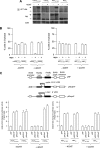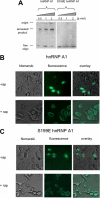Phosphomimetic substitution of heterogeneous nuclear ribonucleoprotein A1 at serine 199 abolishes AKT-dependent internal ribosome entry site-transacting factor (ITAF) function via effects on strand annealing and results in mammalian target of rapamycin complex 1 (mTORC1) inhibitor sensitivity
- PMID: 21454539
- PMCID: PMC3091246
- DOI: 10.1074/jbc.M110.205096
Phosphomimetic substitution of heterogeneous nuclear ribonucleoprotein A1 at serine 199 abolishes AKT-dependent internal ribosome entry site-transacting factor (ITAF) function via effects on strand annealing and results in mammalian target of rapamycin complex 1 (mTORC1) inhibitor sensitivity
Abstract
The relative activity of the AKT kinase has been demonstrated to be a major determinant of sensitivity of tumor cells to mammalian target of rapamycin (mTOR) complex 1 inhibitors. Our previous studies have shown that the multifunctional RNA-binding protein heterogeneous nuclear ribonucleoprotein (hnRNP) A1 regulates a salvage pathway facilitating internal ribosome entry site (IRES)-dependent mRNA translation of critical cellular determinants in an AKT-dependent manner following mTOR inhibitor exposure. This pathway functions by stimulating IRES-dependent translation in cells with relatively quiescent AKT, resulting in resistance to rapamycin. However, the pathway is repressed in cells with elevated AKT activity, rendering them sensitive to rapamycin-induced G(1) arrest as a result of the inhibition of global eIF-4E-mediated translation. AKT phosphorylation of hnRNP A1 at serine 199 has been demonstrated to inhibit IRES-mediated translation initiation. Here we describe a phosphomimetic mutant of hnRNP A1 (S199E) that is capable of binding both the cyclin D1 and c-MYC IRES RNAs in vitro but lacks nucleic acid annealing activity, resulting in inhibition of IRES function in dicistronic mRNA reporter assays. Utilizing cells in which AKT is conditionally active, we demonstrate that overexpression of this mutant renders quiescent AKT-containing cells sensitive to rapamycin in vitro and in xenografts. We also demonstrate that activated AKT is strongly correlated with elevated Ser(P)(199)-hnRNP A1 levels in a panel of 22 glioblastomas. These data demonstrate that the phosphorylation status of hnRNP A1 serine 199 regulates the AKT-dependent sensitivity of cells to rapamycin and functionally links IRES-transacting factor annealing activity to cellular responses to mTOR complex 1 inhibition.
Figures








Similar articles
-
Heterogeneous nuclear ribonucleoprotein A1 regulates cyclin D1 and c-myc internal ribosome entry site function through Akt signaling.J Biol Chem. 2008 Aug 22;283(34):23274-87. doi: 10.1074/jbc.M801185200. Epub 2008 Jun 18. J Biol Chem. 2008. PMID: 18562319 Free PMC article.
-
Mechanistic Target of Rapamycin (mTOR) Inhibition Synergizes with Reduced Internal Ribosome Entry Site (IRES)-mediated Translation of Cyclin D1 and c-MYC mRNAs to Treat Glioblastoma.J Biol Chem. 2016 Jul 1;291(27):14146-14159. doi: 10.1074/jbc.M116.726927. Epub 2016 May 11. J Biol Chem. 2016. PMID: 27226604 Free PMC article.
-
m6A-modification of cyclin D1 and c-myc IRESs in glioblastoma controls ITAF activity and resistance to mTOR inhibition.Cancer Lett. 2023 May 28;562:216178. doi: 10.1016/j.canlet.2023.216178. Epub 2023 Apr 14. Cancer Lett. 2023. PMID: 37061119 Free PMC article.
-
Targeting the translational apparatus to improve leukemia therapy: roles of the PI3K/PTEN/Akt/mTOR pathway.Leukemia. 2011 Jul;25(7):1064-79. doi: 10.1038/leu.2011.46. Epub 2011 Mar 25. Leukemia. 2011. PMID: 21436840 Review.
-
Targeting mTOR globally in cancer: thinking beyond rapamycin.Cell Cycle. 2009 Dec;8(23):3831-7. doi: 10.4161/cc.8.23.10070. Epub 2009 Dec 14. Cell Cycle. 2009. PMID: 19901542 Review.
Cited by
-
Post-translational modifications of hnRNP A1 differentially modulate retroviral IRES-mediated translation initiation.Nucleic Acids Res. 2020 Oct 9;48(18):10479-10499. doi: 10.1093/nar/gkaa765. Nucleic Acids Res. 2020. PMID: 32960212 Free PMC article.
-
Idiosyncrasies of hnRNP A1-RNA recognition: Can binding mode influence function.Semin Cell Dev Biol. 2019 Feb;86:150-161. doi: 10.1016/j.semcdb.2018.04.001. Epub 2018 Apr 9. Semin Cell Dev Biol. 2019. PMID: 29625167 Free PMC article. Review.
-
The protein arginine methyltransferase PRMT5 confers therapeutic resistance to mTOR inhibition in glioblastoma.J Neurooncol. 2019 Oct;145(1):11-22. doi: 10.1007/s11060-019-03274-0. Epub 2019 Aug 31. J Neurooncol. 2019. PMID: 31473880 Free PMC article.
-
hnRNP A/B Proteins: An Encyclopedic Assessment of Their Roles in Homeostasis and Disease.Biology (Basel). 2021 Jul 24;10(8):712. doi: 10.3390/biology10080712. Biology (Basel). 2021. PMID: 34439945 Free PMC article. Review.
-
hnRNP A1: the Swiss army knife of gene expression.Int J Mol Sci. 2013 Sep 16;14(9):18999-9024. doi: 10.3390/ijms140918999. Int J Mol Sci. 2013. PMID: 24065100 Free PMC article. Review.
References
-
- Shi Y., Gera J., Hu L., Hsu J. H., Bookstein R., Li W., Lichtenstein A. (2002) Cancer Res. 62, 5027–5034 - PubMed
-
- Gera J. F., Mellinghoff I. K., Shi Y., Rettig M. B., Tran C., Hsu J. H., Sawyers C. L., Lichtenstein A. K. (2004) J. Biol. Chem. 279, 2737–2746 - PubMed
-
- Shi Y., Sharma A., Wu H., Lichtenstein A., Gera J. (2005) J. Biol. Chem. 280, 10964–10973 - PubMed
Publication types
MeSH terms
Substances
Grants and funding
LinkOut - more resources
Full Text Sources
Other Literature Sources
Molecular Biology Databases
Research Materials
Miscellaneous

